Bell peppers are practically not grown in open ground in the northern regions. The exception is summer residents-experiments, or newcomers who do not know the peculiarities of the culture. In the south, more than half of all plantings occur under natural conditions. This article describes in detail how sweet peppers are grown and cared for in open ground in the middle zone and southern regions.
And about growing pepper seedlings at home written in detail here
| Content:
|
Video about growing bell (sweet) peppers in open ground
Varieties for growing ground peppers in the middle zone
Sweet peppers can grow in open ground only in the south of the Central region; to the north, the crop is grown only in greenhouses. The harvest is highly dependent on the weather; in cold summers it is absent.
Only early ripening varieties are grown outside. Peppers with a longer ripening period do not even have time to form normally, let alone bear fruit.
Varieties of vegetable peppers
Father Frost. Early ripening variety. The bushes are medium-sized. The fruits are shiny, cylindrical, weighing up to 120 g, thick-walled (6-7 mm). The color of the fruit in technical ripeness is dark green, in biological ripeness it is dark red. Intended for fresh use and for preservation.
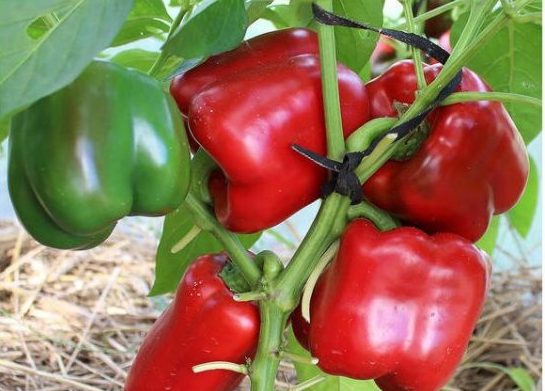 Santa Claus variety |
gold bar. Early ripening, up to 1.2 m high. The fruits are cube-shaped, green in technical ripeness, yellow in biological ripeness. Fruit weight is 160 g, wall thickness is up to 9 mm. The variety is resistant to low temperatures. Suitable for processing and fresh consumption.
Nikitich. Low-growing standard variety. The fruits are cube-shaped, up to 10 cm long, weighing 100 g. The surface is smooth and shiny. Wall thickness 3 mm. In technical ripeness, peppercorns are light yellow, in biological ripeness they are red.
Ermak. Early ripening, low-growing variety. The fruits are small - weighing up to 70 g and up to 10 cm long, trapezoidal in shape with a smooth surface. Wall thickness up to 5 mm. Peppercorns at technical ripeness are light green, at biological ripeness they are red.Used for salads and preservation.
Matryoshka. The variety is early-ripening, low-growing, spreading bush. The fruits grow vertically upward or horizontally, without gloss, and are cone-shaped. The wall thickness is 5-6 mm, weight is 130 g. The color of the fruit is initially yellowish, and red at biological ripeness.
Etude. This is the only early-ripening pepper variety grown in open ground in the Central region, which requires staking and shaping. Although the bushes are up to 100 cm high, they are spreading and form many side shoots. The fruits grow horizontally and downwards, cone-shaped, shiny, light green in technical ripeness and red in biological ripeness. The mass of peppercorns is up to 100 g, the wall thickness is up to 6 mm. The fruits of this variety are decorative in appearance. Used for salads and canning.
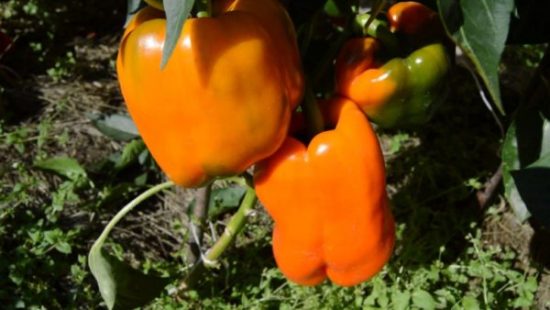 Pepper variety Etude |
Paprika (capsicum) is not grown in open ground, since the fruits are picked only at biological ripeness, and they do not have time to ripen.
Growing sweet peppers in the middle zone
It is very difficult to obtain a crop harvest in open ground. In such conditions, pepper requires much more care and attention than tomatoes or cucumbers
Predecessors
The crop cannot be planted after nightshade crops (tomatoes, potatoes), since they have common diseases. And although bell peppers are much less affected by diseases than tomatoes and potatoes, if they get sick, then all the work will be in vain - there will be no harvest.
Good predecessors are root vegetables, cabbage, peas, beans, beans, zucchini, and pumpkin.
Soil preparation
In the middle zone, favorable conditions for the growth of pepper are only 60-70 days, and in order to get at least some harvest, it is necessary to plant it in the ground early, when the ground has not yet warmed up enough.Therefore, for peppers in open ground, as for cucumbers, make warm beds.
The beds are made in the fall. Use only half-rotted (1.5-2 m bucket)2) and rotted (1.5-2 buckets per m2) manure. Poorly decomposed manure leads to strong growth of tops and a complete absence of flowering and fruiting. Add 20-30 g of superphosphate to the manure. Fertilizers are incorporated into the soil and left until spring.
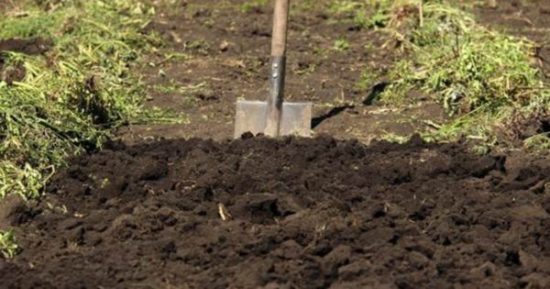 The beds for planting peppers are prepared in the fall. |
In the spring, when the soil thaws, it is watered with hot water and after a few days the seedlings are planted. The earth should be warm to the touch and not cold on your hand.
If there is no manure or the soil is quite fertile and organic matter will be superfluous, then in the fall they add 1 m22 30 g of superphosphate, 1 glass of ash and, if available, a bucket of humus or compost. Instead, you can add food scraps (watermelon and melon peels, banana skins, cabbage leaves) or leaf litter (it is better not to use pine litter, as it strongly acidifies the soil).
If your dacha has heavy clay soil, then peppers will not grow on it. It loves light loams and sandy loam soils. If the soil is too acidic, then it is also not suitable for growing peppers, but this can be corrected by adding lime fertilizers.
- The best is ash: add 1-2 cups per m2 depending on acidity.
- In its absence, fluff is used; it quickly increases the pH of the soil and lasts only 1 year, but after a year the experimenter is unlikely to have the desire to grow bell peppers in open ground again.
- Application rate on light loams 300 g/m2, on sandy soils 200 g/m2.
|
The bed is made in the sunniest place, protected from cold northern winds |
Planting seedlings in open ground
Pepper seedlings are planted in open ground after May 25, when the soil warms up a little, and in early June in a cold, protracted spring. Planting density 6-7 low-growing plants per m2 or 4-5 medium-sized ones. Tall varieties are not grown outdoors in the middle zone. Bushes must have at least 10 true leaves, flowers and buds. It makes no sense to plant less developed seedlings outside.
The holes are watered with boiling water and nitrogen fertilizers (urea, ammonium sulfate) are added. Fertilizers are lightly sprinkled with soil and the plants are planted at the same depth at which they grew in containers. Even overgrown seedlings should not be buried outside, since they will take at least 15 days to adapt, will begin to grow too late, and there will be no harvest from them. It is better to plant elongated plants in a greenhouse, where they can be buried 3-4 cm, where the growing season is somewhat longer and there is a chance to get at least something.
|
The soil around the seedlings is pressed tightly. Planting is carried out on a cloudy day or in the evening. |
If manure was not used when preparing the soil, then the soil around the stem is covered with non-woven material or, better yet, film. First, a hole is cut out in the film, then it is laid around the hole, and then the seedlings are planted. If the ground is covered with a black film, the temperature of the soil under it rises by 2-3°C, and if it is covered with white film, the illumination of the plants additionally increases due to reflected light. Thanks to this, the bushes take root faster, and the yield increases by 10-15%.
Caring for peppers after planting in the ground
Immediately after planting the seedlings in open ground, arcs are installed above them and covered with film. The greenhouse remains for the entire growing season.Since the seedlings of such a heat-loving plant are planted in the ground very early (for pepper), when the nights are still cold, they are additionally insulated with hay, sawdust, leaf litter or rags.
|
Additionally, there is no need to cover the pepper from the bright sun, since the non-woven material itself protects plants well from bright sunlight and the bushes under it will not get burned. |
In the middle zone, frosts occur until June 10, so on the eve of freezing, the peppers are additionally covered with straw, and the greenhouse is covered with a double layer of spunbond and, if the frost is very strong, also with film. If the days are cold, then the film on the greenhouse is lifted for 30-40 minutes to ventilate the pepper, and then closed again. Spunbond, since it allows air to pass through, is not opened at all.
If the temperature during the day is more than 20°C, then the film is removed, the spunbond is raised and the bushes are ventilated. In warm weather, you can leave the peppers open all day. The greenhouse must be closed at night.
The crop will have to be opened during the day and closed at night throughout the season, since in the middle zone at night the temperature is rarely 18°C or higher, and cold nights prevent the growth of peppers
How to water peppers
Water the sweet peppers to a depth of 20 cm, but if it rains, then watering is not required (unless the greenhouse is covered with film), since non-woven materials allow moisture to pass through well. If the weather is dry, then the plants are watered strictly at the root once every 10 days or as the soil dries out. Water should not get on the leaves and buds.
Water only with warm water (not lower than 23-25°C); if the days are cold and cloudy, the irrigation water for the crop will have to be heated.Watering with cold water causes growth to slow down, buds and flowers do not form, and those that have already appeared fall off.
|
After each rain or watering, the plants are carefully and shallowly loosened. |
Feeding sweet peppers
Feeding begins 7-10 days after planting in the ground. If peppers grow in a manure bed, then there is no need to add organic matter or nitrogen fertilizers. If it is grown without manure or very little of it was added, then organic matter is used: semi-rotted manure (1 glass of infusion per bucket if organic matter was added to a minimum, 2 glasses/10 l if the pepper is grown without organic matter), weed infusion.
It is better not to use bird droppings, since they are too concentrated and cause strong growth of tops, delaying flowering and fruiting.
If there is no organic matter, then use mineral fertilizers: urea (1 tbsp/10 l) or ammonium nitrate (1 heaped tbsp/10 l).
Regardless of whether organic or mineral fertilizers are used, 30-40 g of simple superphosphate and 20-30 g of potassium sulfate are added to the fertilizing. Instead, you can use complex fertilizers with microelements. Potassium fertilizers can be replaced with ash (0.5 cups per bush), but superphosphate must be added to it, which is absent in ash.
|
Pepper care. Once a week, 2-3 lower leaves are picked off the stem. Leaves should not be allowed to come into contact with the soil. They are removed before the first branching, then the leaves are not torn off. |
How to care for peppers during flowering and fruiting
With the onset of warm weather (more than 18°C during the day, 10-12°C at night), the mulch made from straw, hay or rags is removed. But the covering material is left until the end of cultivation. In the middle zone, even in July the nights are cold enough for pepper (12-15°C); on rare nights it reaches 18°C.Therefore, the culture must be closed at night, opening during the day. In cold weather, the greenhouse can not be opened since it allows air to pass through, but it is still advisable to open the peppers for at least 10-15 minutes, since condensation accumulates on the spunbond, and bell peppers really don’t like this.
During the fruiting period. exclude nitrogen fertilizers and apply either complex fertilizers with microelements or simple superphosphate (20 g/10 l) with potassium sulfate (20-25 g/10 l).
|
In rainy weather, do not water; in dry weather, water as the soil dries. It is advisable to fertilize with each watering. |
Often in open ground, almost all the flowers and ovaries of peppers fall off. Usually, with normal feeding, the ovaries crumble due to lack of heat. In this case, the pepper is covered with a covering material and is not removed, opening only one side for a short time for ventilation.
Plants do not form. Low-growing bushes on the street practically do not branch.
Pepper pests
Often on plants aphids attack. It settles on the underside of leaves, located along the veins. Insects suck the juices from the plant. The leaves curl down, turn yellow and fall off.
Most often, sweet peppers are attacked by black (melon) aphids; green aphids damage the crop very rarely. Aphids are very persistent and, having appeared once, they return to the garden several times over the summer. Of course, this significantly complicates caring for peppers in open ground.
|
It is not difficult to combat the pest, but it must be done systematically. |
When pests appear, peppers in the garden are sprayed on the underside of the leaves with a solution of soda (1 tbsp. l/5 l of water). Can be treated with biological products Fitoverm or Actofit. Treatments are carried out until the end of the growing season with an interval of 10 days.
Harvest
In the middle zone, ground peppers are collected only at technical ripeness, since they may not ripen on the bushes. As soon as the fruit has acquired a characteristic shade for the variety, it is immediately picked. This also enhances the formation of new ovaries.
|
The pepper harvest in open ground is very modest - 3-4 peppercorns per bush at best. Usually there are a couple of fruits from several bushes, and the rest grow as ornamental plants. |
Problems when growing sweet peppers
Bell pepper is the most difficult open ground crop to grow in the middle zone. With colossal expenditure of effort and resources, there is practically no return.
- Flowers and ovaries fall off the pepper.
- The plant was frozen. The flowers will still fall off, but to increase resistance to unfavorable conditions, the plants are sprayed with biostimulants Bud or Ovary. In cold weather, the bushes are lined with straw, and the greenhouse is covered with a double layer of spunbond.
- Soil too dry. Pepper does not tolerate drying out of the soil and always needs moist soil. Therefore, water it regularly with warm water.
- A sharp difference in day and night temperatures (more than 15°C). If the nights are cold and the day is too hot, then open the greenhouse all day, closing it in the evening when it starts to get colder. Additionally spray the Ovary or Bud. However, in such weather, the plant will still shed its ovaries; the measures taken will only slightly reduce their shedding.
- Pepper doesn't bloom. High nitrogen content in the fertilizer. The soil is watered abundantly and nitrogen fertilizers or organic matter are no longer applied, feeding only with complex fertilizers without nitrogen, but with microelements.
- Apical rot. Green spots appear on the top of the fruit, which dry out over time. Lack of calcium.When blossom end rot plants are sprayed with calcium vuxal or potassium nitrate.
Growing sweet peppers in the south
|
In the south, in open ground with bell peppers there are not nearly as many problems as in the north. The culture grows well outdoors and does not require special care. |
What varieties are suitable for growing?
In the south, all varieties of pepper are grown in open ground except the latest ones, which begin to bear fruit after 150 days or later.
Hybrids are characterized by more favorable fruit production and early ripening compared to varieties. They tolerate unfavorable factors more easily in the first half of the growing season, and their fruits are more even.
Site preparation
- The best predecessors are green crops or lawn grasses.
- Good ones are cabbage, legumes and pumpkin crops, cucumbers.
- You cannot plant peppers after nightshades (tomatoes, eggplants, sweet and hot peppers) for 3-4 years.
The place for growing is chosen in light partial shade so that the plants do not burn in direct sun. If there is no such place, then they are planted in an open area and shaded on sunny days. The crop is not grown in dense shade, as the yield is sharply reduced.
In the fall, potash is added to the digging (15-20 g or 1 cup of ash/m2) and phosphorus (20 g/m2) fertilizers. On chernozems, organic matter is not used, otherwise the pepper will go into the tops to the detriment of the harvest. If the soils are poor, then half-rotted manure is added in the fall (1 bucket per m2).
Sweet peppers cannot tolerate high soil alkalinity, so at high values (pH more than 7.2) alkalization is carried out.
To determine alkalinity, acetic acid is dropped onto a lump of earth. If the soil is alkaline, then a reaction occurs with the release of gas bubbles and hissing.
|
To reduce acidity when digging, peat is added to the soil, and double superphosphate is used as phosphate fertilizers. Both components reduce soil alkalinity. In case of a strongly alkaline reaction, the soil is spilled with a pink solution of potassium permanganate. Having a strongly acidic reaction, it reduces alkalinity by 0.5-1.5 units. |
Transplanting
Seedlings are planted in the ground under covering material in early May, when the temperature is not lower than 15-17°C. Overgrown plants can be buried down to the first true leaves. Although their development will be delayed by 10-15 days, in the end the root system will be more developed, and the harvest will be no less than on other bushes, although somewhat later. When planting at the same level at which the seedlings grew, they are tied up, otherwise they will fall down.
|
In the south, planting is freer, since the bushes branch more actively and require more space. |
- The planting pattern for medium-growing varieties is 60×35 cm, for tall varieties 70×35 cm.
- Low-growing varieties are planted at a distance of 50 cm from each other and 30 cm between rows.
- Hybrids are planted more sparsely because they branch strongly: 80x35 cm or in a checkerboard pattern with a distance between bushes of 70 cm.
Immediately after planting, arches are placed on the plot and covered with covering material. If the temperature at night is below 12°C, then cover with a double layer of lutrasil. Additional insulation of plants is not required, otherwise they may burn during the day in direct sun.
Further care for bell peppers
Shelter
In the south, plants should be shaded from the sun, otherwise the peppers will bake. The covering material is lifted, but not removed at all, leaving shading of the bed.Without shading, plants either get burned and die, or strong evaporation of moisture from the leaves occurs and the bushes always look wilted. When grown in light partial shade, shading is not required. Cover peppers only at the beginning of the growing season, when the temperature at night is below 15-16°C. The rest of the time the plot is left open at night.
Garter
Bushes should not lie on the ground, as this promotes the appearance of diseases. In open ground they are tied to pegs. Tall varieties are grown on a trellis, tying each shoot separately.
|
Fruiting stems must be tied up, since they can break under the weight of the fruit. |
Formation of bell pepper in the ground
In the south, tall peppers form. These varieties branch very strongly and the bushes thicken. Therefore, all weak, thin shoots, stems on which there are no flowers or buds, are cut out.
Typically, tall varieties are grown in 2-3 stems, leaving the strongest shoot in the first and second branches. However, in the south of the Krasnodar Territory and in the Crimea, they can be formed into 3-4 stems.
Before the first branching on the stem, remove the leaves, picking them 2-3 per week. This way a small bole is formed. Do not touch the leaves after branching.
Watering
In the south, bell peppers require frequent watering. When it rains, the soil is wetted only from above and the moisture quickly evaporates. To check soil moisture, stick a stick 10-15 cm deep into the plot. If the stick is dry, then water it even after rain. Watering is carried out as the soil dries. As a rule, at the beginning of the growing season, watering is carried out at intervals of 8-10 days; with the onset of heat, watering is carried out once every 5-7 days, and during fruiting - once every 3-5 days. It’s good to do drip watering for peppers.
|
Peppers in open ground can be watered by sprinkling. |
Watering is carried out exclusively in the evening, when the heat subsides. Sprinkling is carried out until the soil is soaked to a depth of 10-12 cm. If the plants are shaded, then make sure that the covering material does not touch the plants, since wet leaves stick to it. Sprinkling should be alternated with root watering. In case of frequent rains, sprinkling is not carried out.
Loosening
Chernozems are very dense soils and after watering or rain they become covered with a crust that does not allow air to reach the roots. When there is a lack of air in the soil, the consumption of nutrients by the roots slows down, as a result of which the mineral nutrition of the above-ground part deteriorates. Therefore, the soil is carefully and shallowly loosened, trying not to touch the roots. Loosening is carried out after each rain or watering, when the soil dries out.
Feeding
Southern soils, as a rule, contain a sufficient supply of nutrients to obtain a good crop yield. On chernozems they feed 1-2 times per season.
- The first feeding after planting the seedlings is carried out at the root. The bushes are watered with herbal infusion or manure infusion 1:10.
- The second feeding is done in mid-July after the first fruits are collected to enhance growth and fruit formation.
|
Caring for bell peppers |
Use complex fertilizers containing microelements and spray. Or you can feed the weeds at the root with an infusion with the obligatory addition of ash or potash fertilizers and superphosphate. However, if the pepper develops normally, a second feeding is not carried out.
Harvesting
The more often bell peppers are harvested, the faster the remaining ovaries begin to form and new flowers begin to appear. Biological ripeness occurs 20-30 days after technical ripeness.Fruits in technical ripeness are harvested once every 7 days, in biological ripeness - once every 2-3 days. The peppercorns are cut off, making sure to leave the stalk behind.
Paprika (capsicums) is harvested only at biological ripeness.
|
In the southern regions, the crop is harvested in both technical and biological ripeness. |
The collected fruits are immediately put in the shade and covered with a damp cloth so that they do not lose much moisture. If the peppers begin to wrinkle, they will not be stored as well.
- At technical ripeness, peppers are stored at a temperature of 8-12°C and a humidity of 85-90%.
- Fruits in biological ripeness are stored for about a month at a temperature of 1-4°C and the same humidity.
Problems during cultivation
In the south, there are much fewer problems with bell peppers in open ground. It does not require as much effort when grown outdoors as in northern regions, but some difficulties still arise.
- Shedding of flowers and ovaries. Excess nitrogen nutrition. The bushes begin to actively grow green mass, shedding their ovaries. Stop fertilizing with nitrogen or organic matter, and water the soil generously to wash excess fertilizer into the lower layers of the soil. Further, nitrogen is not used in fertilizing and organic matter is no longer fed.
- Fall of flowers. Lack of pollination. Over the entire growing season, the crop produces 50-90 flowers, but only 1/2-1/3 are set, the rest fall off. Bell pepper is a self-pollinating plant, although cross-pollination by insects is possible. The wind carries pollen over a distance of no more than a meter because it is too sticky and heavy. At temperatures above 30°C, pollen does not spill out of the anthers and there is not even self-pollination.To improve the pollination of flowers, artificial pollination is carried out by lightly shaking the bushes or transferring pollen with a brush from one flower to another.
In the south, high yields of sweet peppers can be obtained in open ground.
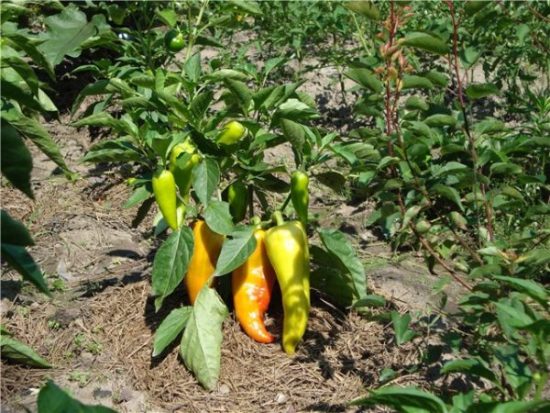

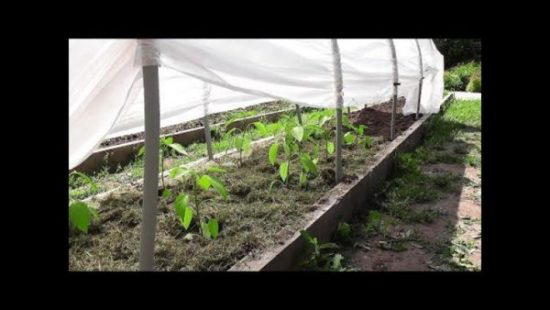
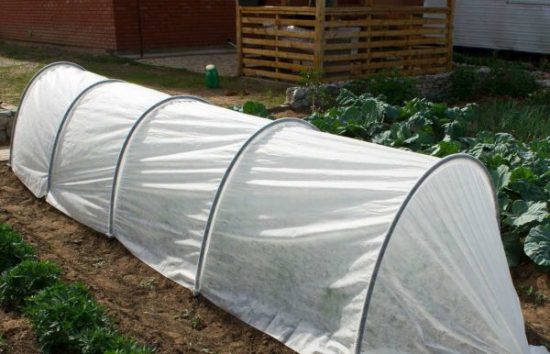
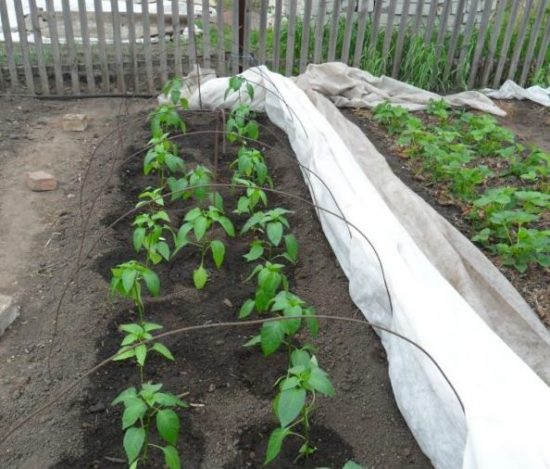
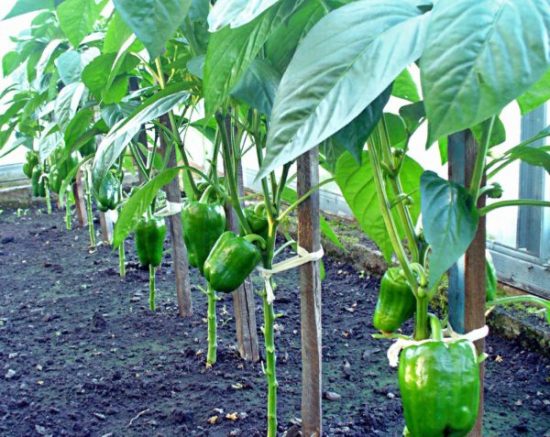
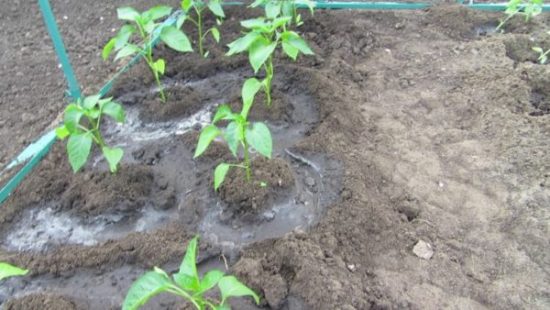
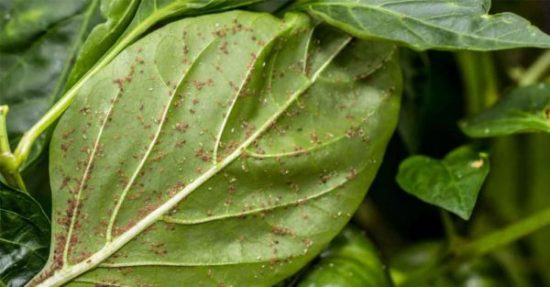
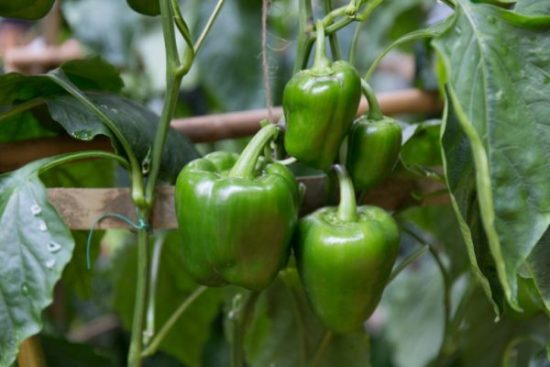
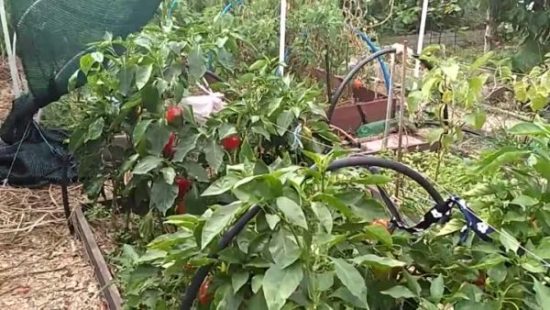

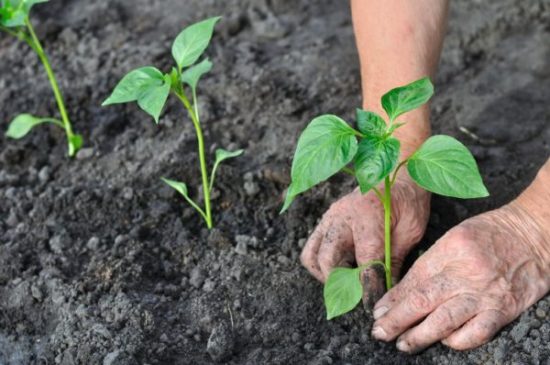
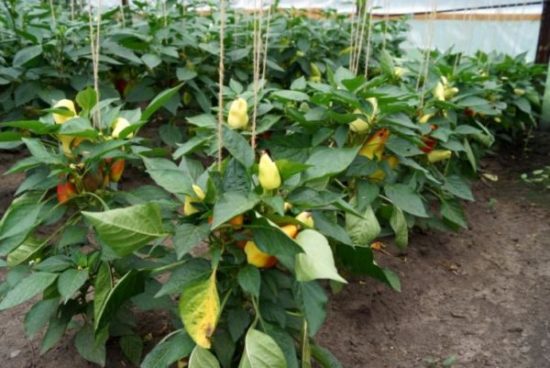
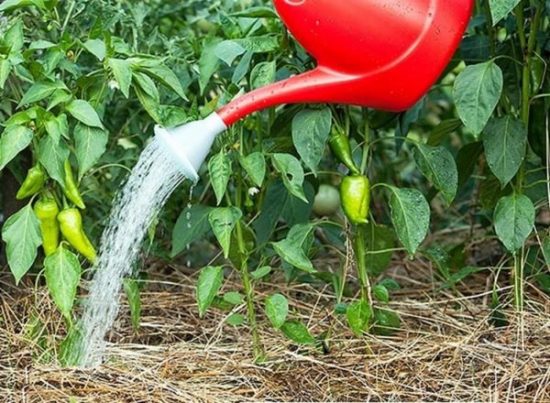
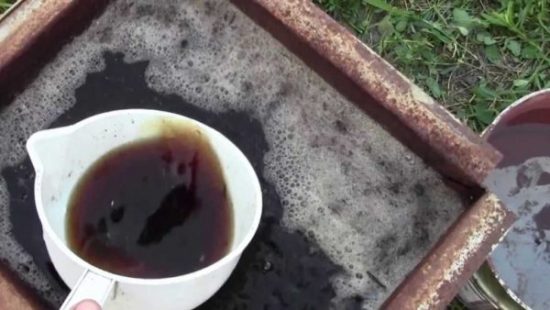

 (5 ratings, average: 4,80 out of 5)
(5 ratings, average: 4,80 out of 5) CUCUMBERS NEVER GET SICK, I'VE BEEN USING ONLY THIS FOR 40 YEARS! I SHARE A SECRET WITH YOU, CUCUMBERS ARE LIKE THE PICTURE!
CUCUMBERS NEVER GET SICK, I'VE BEEN USING ONLY THIS FOR 40 YEARS! I SHARE A SECRET WITH YOU, CUCUMBERS ARE LIKE THE PICTURE! You can dig a bucket of potatoes from each bush. Do you think these are fairy tales? Watch the video
You can dig a bucket of potatoes from each bush. Do you think these are fairy tales? Watch the video
 How our fellow gardeners work in Korea. There is a lot to learn and just fun to watch.
How our fellow gardeners work in Korea. There is a lot to learn and just fun to watch. Eye trainer. The author claims that with daily viewing, vision is restored. They don't charge money for views.
Eye trainer. The author claims that with daily viewing, vision is restored. They don't charge money for views. A 3-ingredient cake recipe in 30 minutes is better than Napoleon. Simple and very tasty.
A 3-ingredient cake recipe in 30 minutes is better than Napoleon. Simple and very tasty. Therapeutic exercises for cervical osteochondrosis. A complete set of exercises.
Therapeutic exercises for cervical osteochondrosis. A complete set of exercises. Which indoor plants match your zodiac sign?
Which indoor plants match your zodiac sign? What about them? Excursion to German dachas.
What about them? Excursion to German dachas.